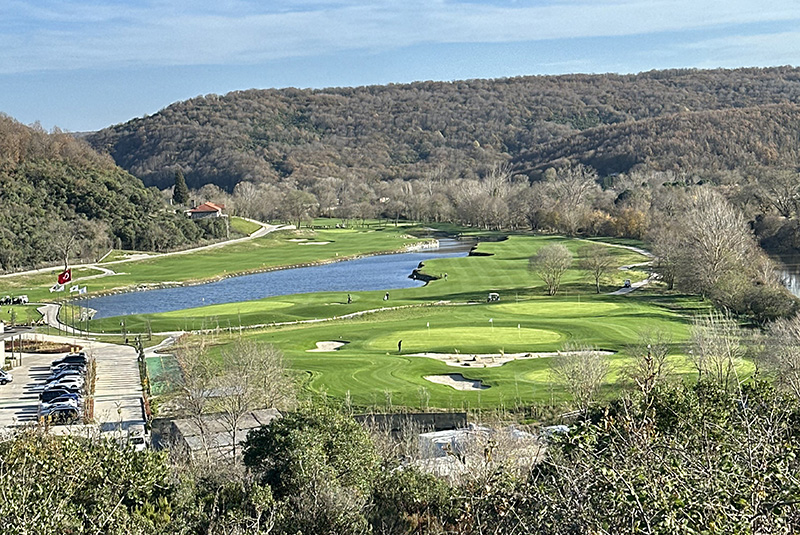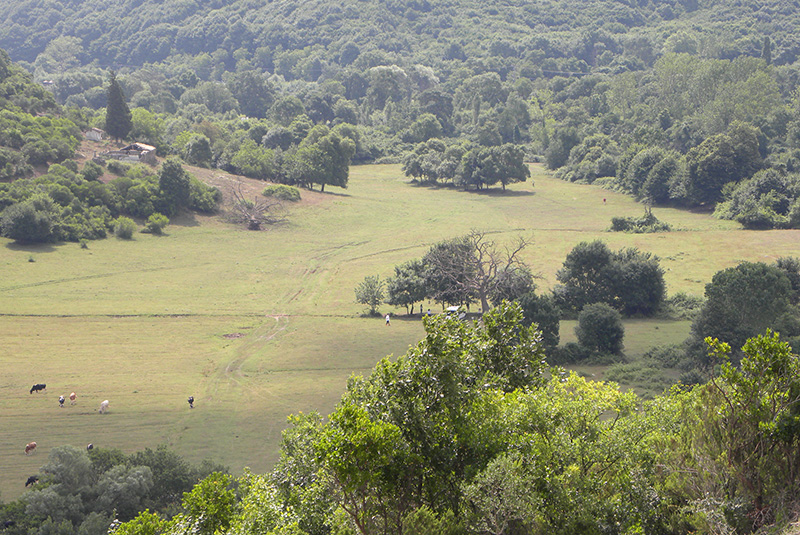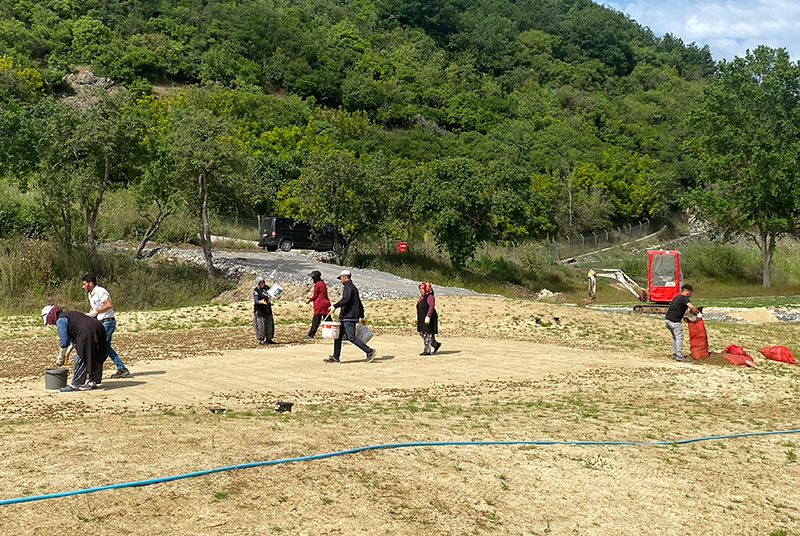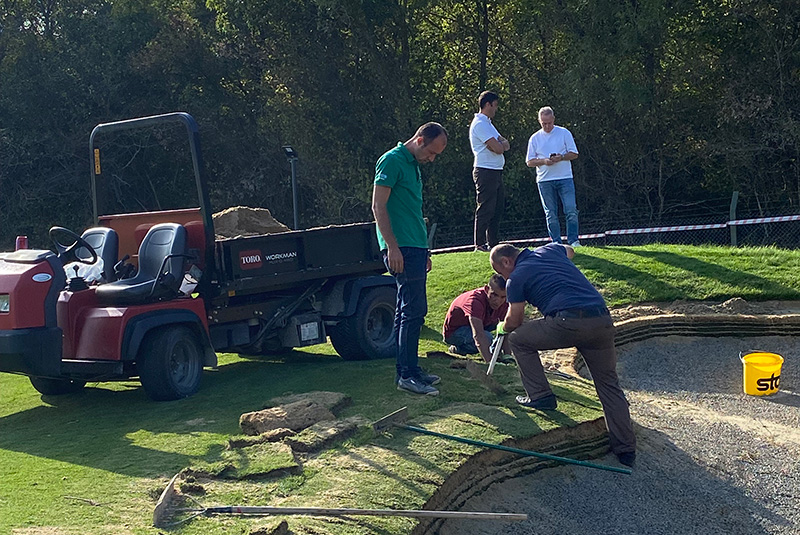
Mustafa Vehbi Koç golf course, part of Istanbul Golf Club in the Beykoz District. Photos courtesy of Carina Okula
In 2018, I consulted on a new nine-hole project to be built in Turkey, in the Beykoz District half an hour northwest of Istanbul. The future golf course was inspired by the late Mustafa Vehbi Koç, a successful businessman and an avid golfer, and his vision was being brought to fruition by his wife, Caroline Koç. It is now known as the MVK golf course and it was meant to provide a venue for the members of the old Istanbul Golf Club in downtown Istanbul, where the long-term lease of the terrain had not been renewed.
On my first visit to the future MVK course, the site was being used to graze cattle.
Architect David Jones, a former PGA European Tour player from Bangor, Ireland was chosen for the design. I had the privilege of working with David previously in Turkey, on National Golf Club in Belek on the Mediterranean coast. I was the grow-in superintendent at National, which was the first golf course in Turkey with a full regulation 18 holes. The Belek region now boasts a dozen or more courses, most designed by prominent international architects.
The turfgrass industry in Turkey is still in its infancy compared to the United States. Prior to the development of golf in the 1990s, the only maintained sports turf was on a few professional soccer fields. Well-cared-for grass was rare on home lawns, parks and cemeteries. At present, there are some 20 golf courses in Turkey and a few distributors of specialized turf machines. Import and transportation costs make the process far more expensive than what American superintendents are used to.
That said, the demand for turf is slowly growing, and there is even a turf nursery in the south of the country, Çimser, which produces a variety of warm-season grasses. There are a few fertilizers available specifically formulated for turf applications, including golf greens. There are practically no pesticides labelled for use on turfgrass, but a wide variety are accessible from the agricultural industry.

The future site of the MVK golf course before its design and construction.
MVK sits at a latitude of 41° north, and is subject to a Mediterranean climate with hot, dry summers and cool, wet winters. Normally cool-season grasses would prove manageable, but the situation here was complicated by the quality and quantity of irrigation water. The water source was a series of eight wells which varied considerably in both salt content and flow. Combined they could provide about two gallons (eight liters) per second of water, amounting to 180,000 gallons (680 cubic meters) per 24-hour period.
For a nine-hole course at peak demand this might suffice, but the real problem was in the salt content. The total dissolved salt in the wells ranged from 300ppm up to 5,000ppm, with a total of 1,500ppm for all wells combined. The site was near the Black Sea, so we could expect the salt content to rise as we pumped water from the aquifer and the sea water seeped in, as indeed was the case as time went on.
To mitigate the deleterious effects of the irrigation water, we devised a plan to segregate the salty wells and the sweet water wells into separate holding ponds. Both were connected to the pipe system so we could pump only the fresh water or the brackish water or both as called for by the situation. The irrigation system is a RainBird Stratus II.
Several observers expressed concern that warm-season grasses could not survive the winters at that latitude. However, I observed common bermudagrass growing in the cow pastures, which led me to believe that it could. As a further precaution, before construction began, we measured soil temperatures throughout the winter. They stayed five to ten degrees above freezing, and I reasoned that if the ground didn’t freeze, the grass would survive.
We ultimately determined warm-season grasses would be preferable to cool-season varieties. It would be difficult to manage bentgrass greens through the dry season from May-September in temperatures from 90-100°F (32 - 38°C) with only brackish water for irrigation. Newer varieties of bermudagrass were not available in-country. Importing stolons is a bureaucratic nightmare and the prospect of passing live plant material through customs and getting it out while it was still viable was dubious at best.
Therefore, we decided to use Pure Dynasty seashore paspalum to seed the greens, which had several advantages. The seed could be imported with minimal red tape. It would survive the salt affected conditions and provide a superior putting surface throughout the summer. Since golf there could be expected year-round at MVK, the warm-season grasses would necessitate winter overseeding, but this was less of a problem. Importing seed was simple and direct and the cooler, rainier winter weather would mitigate the ill-effects of the salt, further aided by the management of the irrigation lakes to isolate the better water.

Seeding the greens on MVK golf course.
The greens were overseeded with Poa trivialis “Quasar” and the tees, fairways, and primary roughs with Lolium perenne “Sun.” They were constructed on 12 inches (30cm) of sand. All the sand used on the project was thoroughly analysed at European Turfgrass Laboratories to compare them against USGA recommendations before approval. No amendments were incorporated into the root zone, but zeolite, organic fertilizer and starter fertilizers were applied to the surface prior to planting.
The golf construction company Golftek covered the greens, tees, bunkers, irrigation and general shaping. We were able to plant some fairway and rough areas in 2022. The greens weren’t ready for seeding until June of 2023. Paspalum seed is slow to germinate, especially under salty conditions, and there was some doubt that there was enough growing weather left to have the greens established before winter. Fortunately, we acquired sprigs from Cullinan Links on the Mediterranean coast, which was in the process of aerating. Their team graciously let us take the cores, which we incorporated into the surface of the greens along with the seed. The greens were playable for a soft opening in October 2023.
The heavy, clay, native soil under the tees and fairways was another issue. Knowing we would likely have a salt problem, I recommended capping the irrigated paspalum area with sand. The fairways and primary roughs were sprigged with Sea Dwarf paspalum, purchased from the Çimser nursery and planted in summer 2023.
Secondary, or outer rough was seeded with a mixture of red fescues and sheep fescue, with the idea that they would be left to grow naturally tall and contrast with the irrigated paspalum. The outer roughs were left in native soil. Since they weren’t irrigated, the salty water wasn’t a problem and we counted on natural rainfall to sustain the turf. Fine fescue grew naturally in the cow pastures with no irrigation or fertilizer before we began construction, so we knew it would survive.

Building out a bunker with Capillary Concrete liner and Eco-Bunker edging.
The bunkers were built to modern industry standards, with Capillary Concrete liner and Eco-Bunker edging, eliminating the risk of washouts, routine edging, weed infestations and regular sand replacement. For those of us who were maintaining golf courses in the 20th century, these products are a godsend, and I only wish we had them years ago. It would have saved a lot of us thousands of hours of backbreaking labor.
I have always had a warm welcome from the Turks, who unfailingly treat me with respect and friendship. Of course there were challenges, especially in the early years when training a maintenance team meant taking on a group of individuals who had never even seen a golf course before, let alone worked on one. Add to that the language barrier, and it could be a slow process. As the industry grew, however, more Turkish people came to be trained by foreign superintendents and the Turks added their own experience. Now, all the Turkish golf courses are managed by their own citizens.
I would like to express my appreciation to everyone involved in the project that made it a success, especially Caroline Koç, David Jones, Andrew Macnabola, Onur Yağcioğlu and Golftek.
Steve Okula, CGCS, MG, is a consultant for SO Green Agronomic Consultancy, and a 40-year AA GCSAA member.